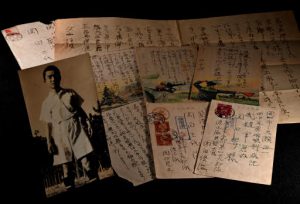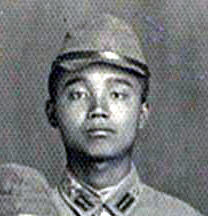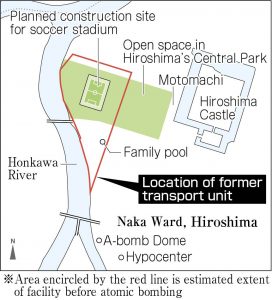Striving to fill voids in Hiroshima, evidence of victims remain 76 years after atomic bombing—Messages from “Shichotai” soldier show love of family
Jul. 13, 2021
Assigned to former army facility whose A-bombed remnants were unearthed at planned site of new soccer stadium
Soldier’s bereaved family kept his postcards and letters
by Kyosuke Mizukawa, Staff Writer
A total of eight postcards and letters, written by a victim of the U.S. atomic bombing named Shunji Okada, then 22, and sent to his family in Tamano, Okayama Prefecture until about a week before the atomic bombing, have been found in the possession of his bereaved family. Mr. Okada was a member of the former Japanese Army’s transport unit known as the Chugoku District transport soldier recruitment unit (“Shichotai” in Japanese). The Shichotai base, located within one kilometer of the hypocenter and completely destroyed in the atomic bombing, is among the largest A-bombed remnants discovered. It was unearthed in an excavation survey conducted in the open space of Hiroshima’s Central Park in the city’s Naka Ward, ahead of the planned construction this year of a soccer stadium on the site. “Our museum has in its archives only a few items related to the Shichotai unit. So this finding represents valuable material for understanding the reality of the Shichotai unit’s soldiers,” said an official of the Hiroshima Peace Memorial Museum.
Mr. Okada was a forward on his soccer team at Okayama Prefectural No. 2 Junior High School (now Okayama Sozan Senior High School in that city’s Naka Ward), which won the championship in the prefectural tournament and other competitions. In 1944, he responded to a call-up for military service and was assigned to the Shichotai unit in May 1945.
His eight postcards and letters were dated from June 19 until July 30, 1945. For his return address, he would write “Chugoku (formerly called Middle) unit No. 139,” the name used commonly for the Shichotai unit, when he sent the messages to his parents. Except for one, all of the communications bear a “Censored” stamp.
In a letter to his father dated July 18, Mr. Okada wrote, “We haven’t had any bombings here yet, but the city is being prepared for complete evacuation step by step. My appetite is good and I’m working hard.” Another of his letters, dated July 30, reads, “A B24 (U.S. military plane) was shot down, and I witnessed with my scope a poor American soldier landing by parachute. Our area here didn’t suffer any damage at all.” In his messages, he often seemed to be trying to convey how he was doing and to reassure his family about his situation.
In his letters and postcards, Mr. Okada also wrote extensively about his concern for his family. One of them (dated June 27) reads, “I was told bombs were dropped in the southeast area of Okayama. Are you all okay?” Another (dated July 28) reads, “I heard the news that a ground attack was taking place in Tamano City. Is everything all right?” He frequently worried about attacks by the U.S. military on his hometown.
On August 6, 1945, the Shichotai facility was completely destroyed. Mr. Okada, suffering burns and injuries to his head, died eight days after the bombing. His parents for a long time kept as mementos of him his postcards and letters as well as a photograph taken of him when he was a junior high school student. With time, Masakatsu Takeyari, 76, Mr. Okada’s nephew and resident of Hiroshima’s Minami Ward, inherited the items.
Regarding Mr. Okada’s postcards and letters, Hironobu Ochiba, chief curator at the Peace Memorial Museum, said, “In contrast to the bravery that we associate with military personnel, his writings tell us the simple sentiments of a young man who cared about his family.” Mr. Takeyari, regarding his own wishes, said, “I hope the remnants of the Shichotai unit are preserved in some way and that information on the victims in the unit like my uncle is conveyed along with the artifacts.” He indicated that he was going to donate Mr. Okada’s artifacts to the museum in the near future.
Keywords
Chugoku District transport soldier recruitment unit
The Chugoku District transport soldier recruitment unit was assigned to transport arms, ammunition, and food using horses and motor vehicles. Soldiers were trained on site and dispatched to various battlefields. Starting as the fifth platoon of transport soldiers on the west side of Hiroshima Castle in 1880, the unit grew larger and changed names over time. According to the Hiroshima Shicho Heitai Shi (History of Hiroshima Transport Soldiers, in English), published in 1973, 423 people were killed or designated as missing and 343 people were injured in the atomic bombing.
(Originally published on July 13, 2021)









